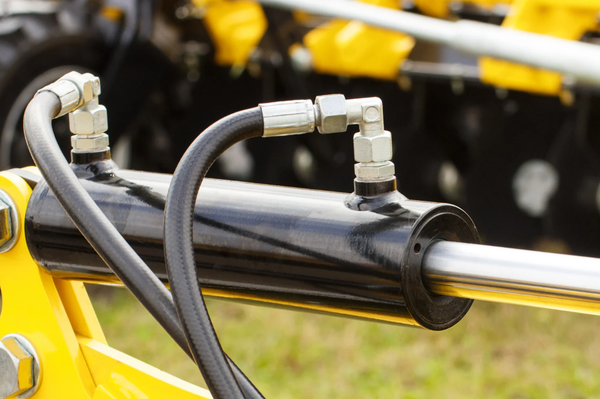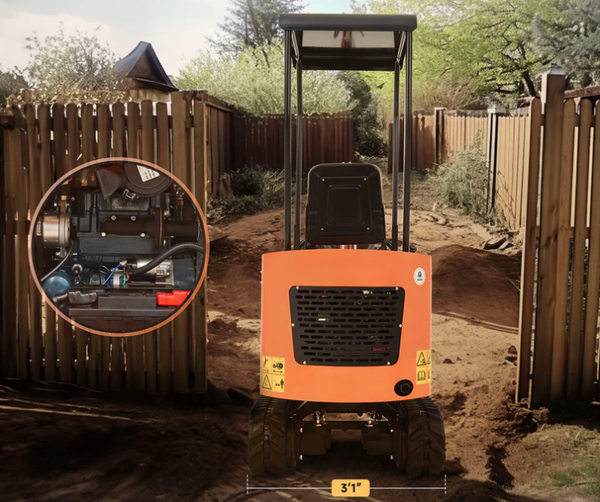Free Shipping Within USA | 1-year Warranty | Self Pick Up
How to Check Hydraulic Oil Level on Excavator?
Whether you maintain your home by becoming a keen DIY-ist, work in construction, or landscaping, mini excavators are incredibly useful.
But to allow them to realize their full potential, you really need to pay attention. You should check your hydraulic oil level to keep it working efficiently.
In this guide, you will learn how to check hydraulic oil level on excavator. But first, let’s show you why checking hydraulic oil is such a big deal.

Why Hydraulic Oil Matters?
Here are a few of the ways that hydraulic oil helps keep this machine functioning properly and efficiently:
- Power Transmission: Hydraulic oil conveys power from the engine to different parts of the excavator. And this fluid power means the machine can deliver great force with little mechanical complexity.
- Lubrication: Because the hydraulic oil passes through every moving part, it helps to lubricate them and make sure they do not actually rub against each other. By preventing untimely component failure, this lubrication extends the life of your engine.
- Heat dissipation: During the operation of the hydraulic system there is a significant generation of heat. This heat is absorbed by the oil, which it carries away from sensitive parts to aid in keeping components of your engine at ideal running temperatures and not allowing them to overheat.
These are already enough reasons to check your oil levels. Your mini excavator will thank you.
Step-by-Step Guide: How to Check Hydraulic Oil Level on Excavator
Good hydraulic oil maintenance starts with scheduled checks. Here is how to check your mini excavator hydraulic oil level the right way:
Step 1: Park on Level Ground
Park the mini excavator on level ground. It also provides an accurate oil level reading, eliminating false low or high readings.
Step 2: Lower Attachments
Fully lower the boom, arm, and bucket. This drains the most amount of hydraulic oil back to the reservoir which will increase your accuracy when checking for proper fluid level in the system.
Step 3: Shut Down the Machine
Turn off your mini excavator and let it cool down, ideally for a minimum of 30 minutes. This
cooling phase is important for two reasons:
- It lets the hydraulic oil sit in the tank and helps get a more accurate reading of the level.
It minimizes the potential for burns from hot oil/or parts during the check.

Step 4: Find the Oil Reservoir
Find the Hydraulic Oil Reservoir (See where your manual tells you to fill hydraulic oil). It is usually marked with a hydraulic oil symbol.
Step 5: Area Cleaning
Clean the area around your oil reservoir cap or dipstick before you open it. This way, contaminants do not enter the system during inspection.
Step 6: Check the Oil Level
Mini excavators differ. On some models, you will have a sight glass for checking the oil levels. On other models, you’ll have the typical dipstick.
Sight Glass Method: if you have a sight glass on the side of your excavator, all you have to do is look at it to see if the oil level is right. It should be between minimum and maximum markers.
Dipstick Method: Remove the dipstick and dry it with a clean lint-free rag. After that push in all the way back then pull it out again to check the oil level. It will be between the add and pass line on a dipstick for old oil. If it is low, you will need to learn how to add hydraulic fluid to excavator.
Step 7: Check Oil Quality
In addition to monitoring the level, inspect its consistency as well for:
- Color: Clean hydraulic oil should be translucent and amber in color. Dark or cloudy oil may indicate contamination or degradation.
- Smell: Hydraulic oil when clean, fresh, and uncontaminated, has a mild characteristic odor. A burnt smell (due to overheating) and a sour-smelling odor (chemical breakdown) are not good signs.
Texture: Apply a small amount of oil to your fingers it should feel smooth. If there is any grit, it has been contaminated with particulates.
Step 8: Keep a Record of the Results
Track your oil checks noting the date, level, and in general, how the oil seems to you. You can then reference this record to detect patterns and predict maintenance requirements.

Low Hydraulic Fluid Symptoms to Watch For
Being proactive in identifying potential issues can save you time and money. Here are some key symptoms that might indicate low hydraulic fluid:
A
Slow or erratic movement of hydraulic components Unusual noises, such as whining or cavitation sounds
Higher than normal operating temperatures
Visible leaks under the machine or around hydraulic components
Loss of power or reduced lifting capacity
Difficulty in controlling the excavator’s movements
Any of these symptoms can point to poor quality or low oil level. Check hydraulic oil levels immediately. The earlier you address any issues before operating the machine, the better.
Maintenance Beyond Fluid Checks
. Filter Changes: Regularly replace hydraulic filters according to your manufacturer’s recommendations. Clean filters prevent contaminants from damaging your system.
- System Inspection: Inspect hoses, fittings, and seals for leaks or wear.
- Oll Analysis: Consider sending oil samples for analysis periodically. This can reveal internal wear issues before they become serious problems.
- Temperature Management: Monitor hydraulic oil temperature during operation. Excessive heat could break down the oil and damage parts.
The Importance of Quality Hydraulic Fluid for Excavator
Using high-quality excavator hydraulic oil can:
Improve system efficiency
Extend component life
Enhance performance in extreme temperatures
Reduce maintenance costs over time

Mistakes to Avoid When Checking Hydraulic Fluid
Avoid these common errors to ensure accurate readings and proper maintenance:
Checking on uneven ground: This can lead to false readings.
Overfilling: Too much oil can cause foaming and system damage.
Using the wrong type of fluid: Always use the manufacturer-recommended oil.
Neglecting to clean the area: Dirt entering the system can cause significant problems.
Ignoring small leaks: Address any leaks promptly to prevent system failure.
Do You Check Hydraulic Fluid Hot or Cold?
This is a common concern among excavator operators. No matter what state the oil is in, your best bet for a trustworthy reading comes if it’s cool. Here’s why:
- Hot oil expands, which can lead to overfilling if checked when warm.
Checking cold oil gives you a more consistent baseline for comparison over time.
The oil is cooler and therefore if you splash yourself, there will be less injury.
But again, this varies with recommendations from the machine’s maker so always use your manual.
Remember, adding too much oil can be just as problematic as having too little. Always aim for the manufacturer’s recommended level.
Conclusion
The strategies we’ve covered in this gulde will elongate your machine’s life. They will also make it operate more efficiently and reliably on Job sites. As we always say: proactive maintenance is cheaper than reactive repairs.
By following the advice above (and your machine-specific manual), your machine will stay in great condition for years and it will be a reliable piece of gear to power through any kind of job.
No need for hydraulic system failure to thwart your projects or raise your operating expenses. For best mini excavators with excellent hydraulic system, check out AHM’s range of powerful, durable mini excavators built to handle the toughest Job site conditions.
Read more related articles: How to Add Hydraulic Fluid to Excavator
